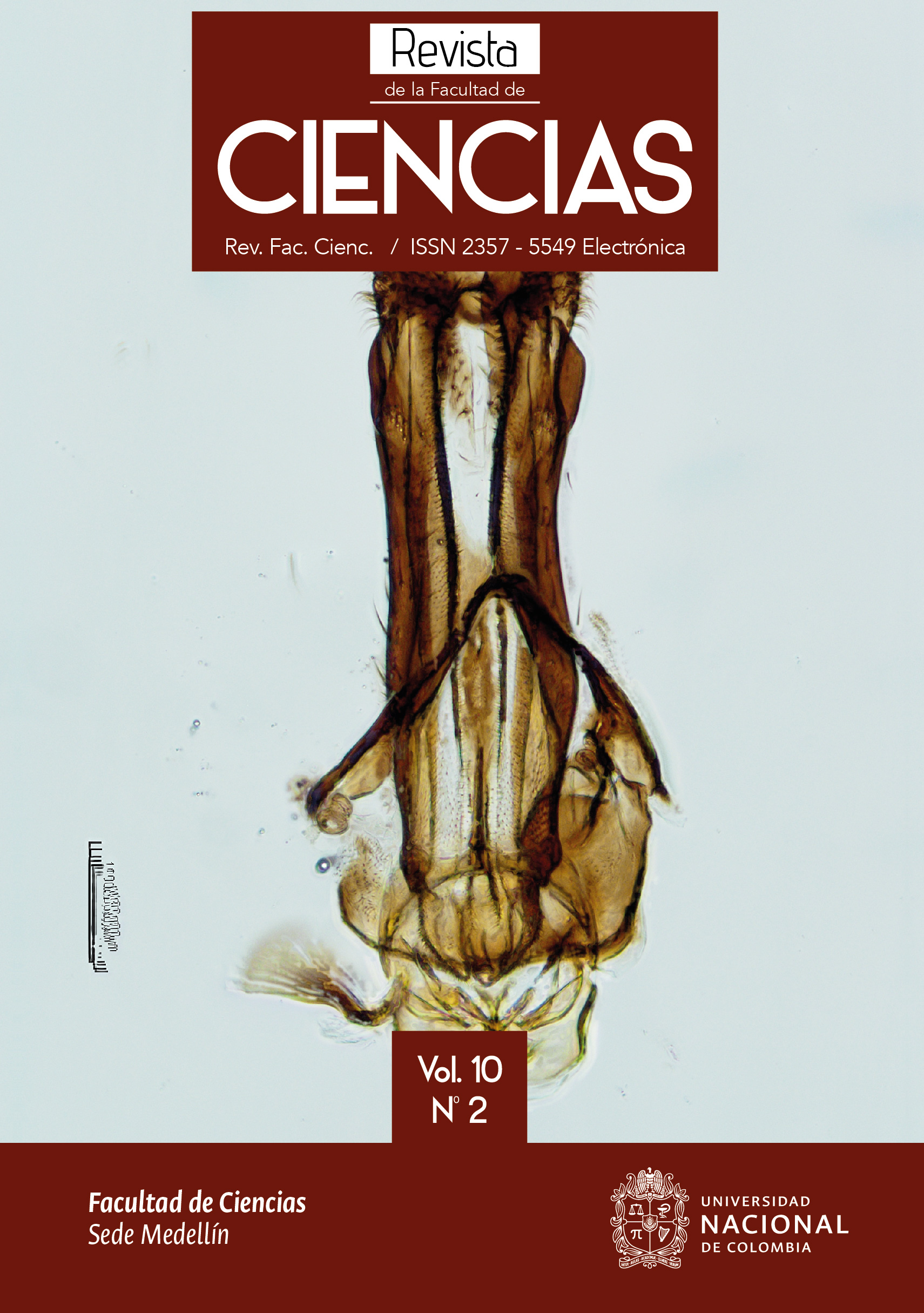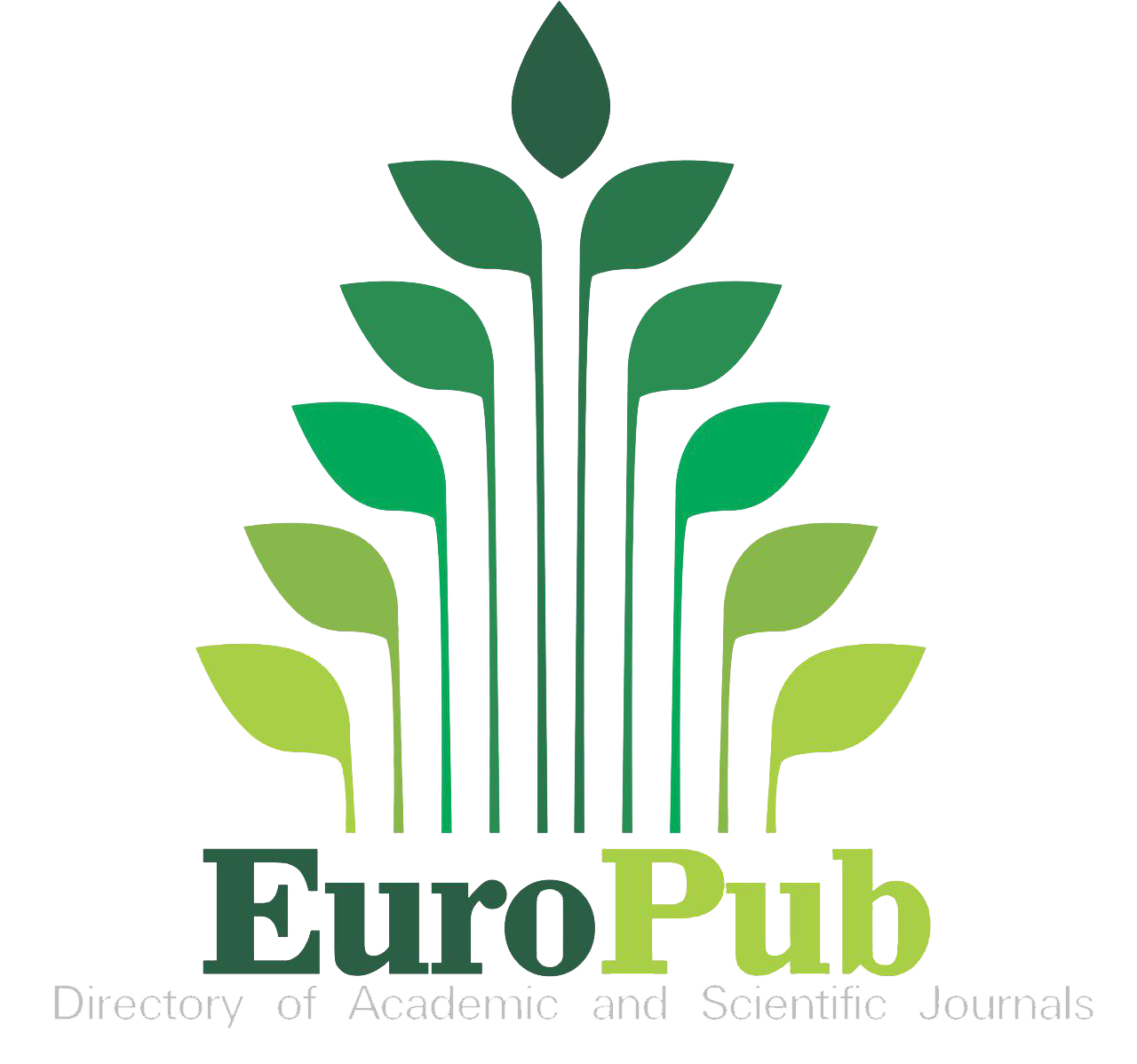PRODUCCIÓN DE ENTROPÍA EN UN MODELO AUTOCATALÍTICO NO-ISOTÉRMICO PERTURBADO CON PULSOS DE ANALITO
ENTROPY PRODUCTION IN A NON-ISOTHERMAL ANALYTE PERTURBED AUTOCATALYTIC MODEL
DOI:
https://doi.org/10.15446/rev.fac.cienc.v10n2.83839Palabras clave:
Oscilador químico no-isotérmico, Lotka-Volterra, Perturbación con pulso de analito, Generación de entropía (es)Non-isothermal chemical oscillator, Lotka-Volterra, Analyte Pulse Perturbation, Entropy generation (en)
Descargas
Referencias
Barragán, D. (2015). Essentials of kinetics and thermodynamics for understanding chemical oscillations.Foundations of Chemistry, 17(2), 93-106. DOI: https://doi.org/10.1007/s10698-015-9221-4
Barragán, D., ́Agreda, J., Parra, W. (2015). Entropy production in the Oregonator model perturbed in a calorimeter with a chemical pulse.Journal of Thermal Analysis and Calorimetry, 119(1), 705-713. DOI: https://doi.org/10.1007/s10973-014-4129-0
Berryman, A. A. (1992). The origins and evolution of predator-prey theory. Ecology, 73(5), 1530-1535. DOI: https://doi.org/10.2307/1940005
Boyce, W. E., DiPrima, R. C., Meade, D. B. (2017). Elementary Differential Equations. 11th Edition. Wiley.
De Kepper, P., Epstein, I. R. (1982). Mechanistic study of oscillations and bistability in the Briggs-Rauscher reaction. Journal of the American Chemical Society, 104(1), 49-55. DOI: https://doi.org/10.1021/ja00365a012
Dolnik, M., Marek, M. (1988). Extinction of oscillations in forced and coupled reaction cells.TheJournal of Physical Chemistry, 92(9), 2452-2455. DOI: https://doi.org/10.1021/j100320a014
Dutt, A. K., Mueller, S. C. (1993). Effect of stirring and temperature on the Belousov-Zhabotinskiireaction in a CSTR.The Journal of Physical Chemistry, 97(39), 10059-10063. DOI: https://doi.org/10.1021/j100141a027
Epstein, I. R., Pojman, J. A. (1998). An introduction to nonlinear chemical dynamics: oscillations,waves, patterns, and chaos. Oxford University Press. DOI: https://doi.org/10.1093/oso/9780195096705.003.0011
Field, R. J., Koros, E., Noyes, R. M. (1972). Oscillations in chemical systems. II. Thorough analysisof temporal oscillation in the bromate-cerium-malonic acid system.Journal of the AmericanChemical Society, 94(25), 8649-8664. DOI: https://doi.org/10.1021/ja00780a001
Fort, H. (2018). On predicting species yields in multispecies communities: Quantifying the accuracyof the linear Lotka-Volterra generalized model.Ecological modelling, 387, 154-162. DOI: https://doi.org/10.1016/j.ecolmodel.2018.09.009
Fujieda, S., Ogata, H. (1996). Calorimetry and potentiometry of chemical oscillations in Briggs-Rauscher reactions with simultaneous measurements of the produced oxygen volume.Talanta, 43(11), 1989-1995. DOI: https://doi.org/10.1016/0039-9140(96)01988-1
Garden, J. L. (2007). Macroscopic non-equilibrium thermodynamics in dynamic calorimetry.Thermochimica Acta, 452(2), 85-105. DOI: https://doi.org/10.1016/j.tca.2006.08.017
Gray, P. (1980). Thermokinetic oscillations in gaseous systems.Berichte der Bunsengesellschaft furphysikalische Chemie, 84(4), 309-315. DOI: https://doi.org/10.1002/bbpc.19800840404
Guerra, N. P. (2014). Modeling the batch bacteriocin production system by lactic acid bacteria byusing modified three-dimensional Lotka–Volterra equations.Biochemical engineering journal, 88, 115-130. DOI: https://doi.org/10.1016/j.bej.2014.04.010
H ̈anggi, P.; Talkner, P.; Borkovec, M. (1990). Reaction-rate theory: Fifty years after Kramers.Reviews of Modern Physics, 62(2), 251-341. DOI: https://doi.org/10.1103/RevModPhys.62.251
Incropera, Frank P. (1999). Fundamentos de transferencia de calor. Cuarta edici ́on. Prentice Hall.
Jimenez-Prieto, R., Silva, M., Perez-Bendito, D. (1995). Analyte pulse perturbation technique: atool for analytical determinations in far-from-equilibrium dynamic systems.Analytical Che-mistry, 67(4), 729-734. DOI: https://doi.org/10.1021/ac00100a007
Klotz, I. M., Rosenberg, R. M. (2008) Chemical Thermodynamics: Basic concepts and methods.Seventh Edition. Wiley-Interscience.
Kondepudi, D. (2008). Introduction to modern thermodynamics. Wiley.
Murgatroyd, P. R., Sonko, B. J., Wittekind, A., Goldberg, G. R., Ceesay, S. M., Prentice, A. M.(1993). Non–invasive techniques for assessing carbohydrate flux: I. measurement of depletionby indirect calorimetry.Acta physiologica scandinavica, 147(1), 91-98. DOI: https://doi.org/10.1111/j.1748-1716.1993.tb09476.x
Noszticzius, Z., Noszticzius, E., Schelly, Z. A. (1983). Use of ion-selective electrodes for monito-ring oscillating reactions. 2. Potential response of bromide-iodide-selective electrodes in slowcorrosive processes. Disproportionation of bromous and iodous acids. A Lotka-Volterra modelfor the halate driven oscillators.The Journal of Physical Chemistry, 87(3), 510-524. DOI: https://doi.org/10.1021/j100226a027
Prigogine, I.(1961). Introduction to thermodynamics of irreversible processes New York: IntersciencePublishers.
Reddy, D. R., Sen, A., Johnston, G. L. (1998). Time delay induced death in coupled limit cycleoscillators.Physical Review Letters, 80(23), 5109-5112. DOI: https://doi.org/10.1103/PhysRevLett.80.5109
Ren, J., Zhang, X., Gao, J., Yang, W. (2013). The application of oscillating chemical reactions toanalytical determinations.Open Chemistry, 11(7), 1023-1031. DOI: https://doi.org/10.2478/s11532-013-0239-y
Roelofs, M. G. (1988). Heat production in steady states and oscillations.The Journal of chemicalphysics, 88(9), 5516-5524. DOI: https://doi.org/10.1063/1.454563
Schneider, F. W. (1985). Periodic perturbations of chemical oscillators: experiments.Annual Reviewof Physical Chemistry, 36(1), 347-378. DOI: https://doi.org/10.1146/annurev.pc.36.100185.002023
Sen, S., Riaz, S. S., Ray, D. S. (2008). Temperature dependence and temperature compensationof kinetics of chemical oscillations; Belousov-Zhabotinskii reaction, glycolysis and circadianrhythms.Journal of theoretical biology, 250(1), 103-112. DOI: https://doi.org/10.1016/j.jtbi.2007.08.029
Sgarlata, C., Zito, V., Arena, G. (2013). Conditions for calibration of an isothermal titrationcalorimeter using chemical reactions.Analytical and bioanalytical chemistry, 405(2-3), 1085-1094. DOI: https://doi.org/10.1007/s00216-012-6565-7
Skvortsov, A., Ristic, B., Kamenev, A. (2018). Predicting population extinction from early obser-vations of the Lotka–Volterra system.Applied Mathematics and Computation, 320, 371-379. DOI: https://doi.org/10.1016/j.amc.2017.09.029
Vanag, V. K., Smelov, P. S., Klinshov, V. V. (2016). Dynamical regimes of four almost identicalchemical oscillators coupled via pulse inhibitory coupling with time delay.Physical ChemistryChemical Physics, 18(7), 5509-5520. DOI: https://doi.org/10.1039/C5CP06883E
Vidal, C., Noyau, A. (1980). Some differences between thermokinetic and chemical oscillatingreactions.Journal of the American Chemical Society, 102(22), 6666-6671. DOI: https://doi.org/10.1021/ja00542a002
Villanueva-Marroquín, J., Barragán, D. (2009). Análisis de la producción de entropía en una máquina térmica operada con un sistema químico no-lineal. Revista mexicana de ingeniería química, 8(1), 145-152.
Xu, F., Gan, W. (2019). On a Lotka–Volterra type competition model from river ecology.NonlinearAnalysis: Real World Applications, 47, 373-384. DOI: https://doi.org/10.1016/j.nonrwa.2018.11.011
Zeyer, K. P., Mangold, M., Gilles, E. D. (2001). Experimentally coupled thermokinetic oscillators:phase death and rhythmogenesis.The Journal of Physical Chemistry A, 105(30), 7216-7224. DOI: https://doi.org/10.1021/jp0041454
Zhang, W., Uddin, W., Hu, G., Hu, L., Fang, Z. (2018). Identification of four isomers of Dihy-droxynaphthalene by using a Briggs-Rauscher oscillating system. Journal of lectroanalytical Chemistry, 823, 378-387 DOI: https://doi.org/10.1016/j.jelechem.2018.06.024
Cómo citar
APA
ACM
ACS
ABNT
Chicago
Harvard
IEEE
MLA
Turabian
Vancouver
Descargar cita
CrossRef Cited-by
1. Jean P. Montoya, Alexander Contreras-Payares, Daniel Barragán. (2024). The Formalism of Chemical Thermodynamics Applied to an Oscillatory Multistep Chemical System. Ingeniería e Investigación, 44(2), p.e108212. https://doi.org/10.15446/ing.investig.108212.
Dimensions
PlumX
Visitas a la página del resumen del artículo
Descargas
Licencia
Derechos de autor 2021 Revista de la Facultad de Ciencias

Esta obra está bajo una licencia internacional Creative Commons Atribución-NoComercial-SinDerivadas 4.0.
Los autores o titulares del derecho de autor de cada artículo confieren a la Revista de la Facultad de Ciencias de la Universidad Nacional de Colombia una autorización no exclusiva, limitada y gratuita sobre el artículo que una vez evaluado y aprobado se envía para su posterior publicación ajustándose a las siguientes características:
1. Se remite la versión corregida de acuerdo con las sugerencias de los evaluadores y se aclara que el artículo mencionado se trata de un documento inédito sobre el que se tienen los derechos que se autorizan y se asume total responsabilidad por el contenido de su obra ante la Revista de la Facultad de Ciencias, la Universidad Nacional de Colombia y ante terceros.
2. La autorización conferida a la revista estará vigente a partir de la fecha en que se incluye en el volumen y número respectivo de la Revista de la Facultad de Ciencias en el Sistema Open Journal Systems y en la página principal de la revista (https://revistas.unal.edu.co/index.php/rfc/index), así como en las diferentes bases e índices de datos en que se encuentra indexada la publicación.
3. Los autores autorizan a la Revista de la Facultad de Ciencias de la Universidad Nacional de Colombia para publicar el documento en el formato en que sea requerido (impreso, digital, electrónico o cualquier otro conocido o por conocer) y autorizan a la Revista de la Facultad de Ciencias para incluir la obra en los índices y buscadores que estimen necesarios para promover su difusión.
4. Los autores aceptan que la autorización se hace a título gratuito, por lo tanto renuncian a recibir emolumento alguno por la publicación, distribución, comunicación pública y cualquier otro uso que se haga en los términos de la presente autorización.
5. Todos los contenidos de la Revista de la Facultad de Ciencias, están publicados bajo la Licencia Creative Commons Atribución – No comercial – Sin Derivar 4.0.
MODELO DE CARTA DE PRESENTACIÓN y CESIÓN DE DERECHOS DE AUTOR





















